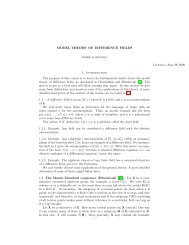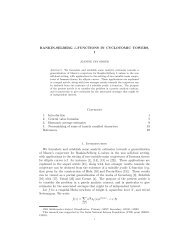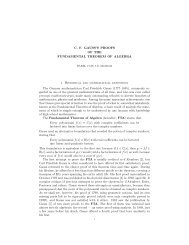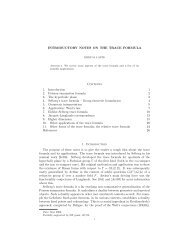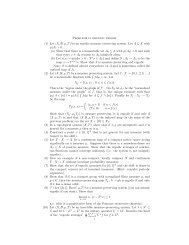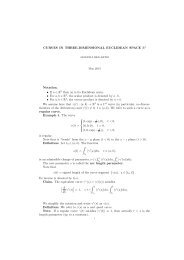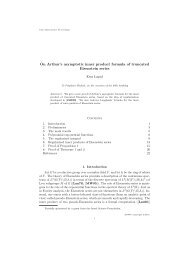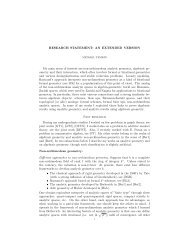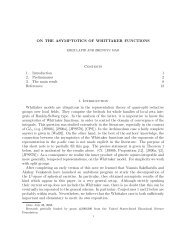The error rate of learning halfspaces using kernel-SVM
The error rate of learning halfspaces using kernel-SVM
The error rate of learning halfspaces using kernel-SVM
Create successful ePaper yourself
Turn your PDF publications into a flip-book with our unique Google optimized e-Paper software.
<strong>The</strong> pro<strong>of</strong> <strong>of</strong> <strong>The</strong>orem 2.7To prove <strong>The</strong>orem 2.7, we prove, <strong>using</strong> John’s Lemma (Matousek, 2002), that for every embeddingψ : S d−1 → B 1 , we can construct a <strong>kernel</strong> k : S d−1 × S d−1 → R and a probabilitymeasure µ N over S d−1 with the following properties: If f is an approximate solution <strong>of</strong> pro-(gram (4), where γ fraction <strong>of</strong> the distribution D is perturbed by µ N , then ‖f‖ k ≤ OUsing this, we adapt the pro<strong>of</strong> as sketched above to prove <strong>The</strong>orem 2.7.3 Additional ResultsLow dimensional distributions. It is <strong>of</strong> interest to examine <strong>The</strong>orem 2.6 when D issupported ( on B d for d small. We show that for d = O(log(1/γ)), the approximation ratio is1Ω √ γ·poly(log(1/γ))). Most commonly used <strong>kernel</strong>s (e.g., the polynomial, RBF, and Hyperbolictangent <strong>kernel</strong>s, as well as the <strong>kernel</strong> used in (Shalev-Shwartz et al., 2011)) are symmetric.Namely, for all unit vectors x, y ∈ B, k(x, y) := 〈ψ(x), ψ(y)〉 H1 depends only on 〈x, y〉 H .For symmetric <strong>kernel</strong>s, we show that even with the restriction that d = O(log(1/γ)), the(approximation ratio is still Ω1γ·poly(log(1/γ))m 1.5γ).). However, the result for symmetric <strong>kernel</strong>s isonly proved for (idealized) algorithms that return the exact solution <strong>of</strong> program (5).<strong>The</strong>orem 3.1 Let A be a <strong>kernel</strong>-based learner corresponding to a Lipschitz surrogate. Assumethat m A (γ) = exp(o(γ −1/8 )). <strong>The</strong>n, for every γ > 0, there exists a distribution D onB d , for d = O(log(m A (γ)/γ)), such that, w.p. ≥ 1 − exp(−1/γ),Err D,0−1 (A(γ))Err γ (D)()1≥ Ω √ .γ · poly(log(mA (γ)))<strong>The</strong>orem 3.2 Assume that m A (γ) = exp(o(γ −2/7 )) and ψ is continuous and symmetric.For every γ > 0, there exists a distribution ( D on B d ), for d = O(log(m A (γ))) and a solutionto program (5) whose 0-1-<strong>error</strong> is Ω· Err γ (D).1γ poly(log(m A (γ)))<strong>The</strong> integrality gap. In bounding the approximation ratio, we considered a predefinedloss l. We believe that similar bounds hold as well for algorithms that can choose l accordingto γ. However, at the moment, we only know to lower bound the integrality gap, as definedbelow.If we let l depend on γ, we should redefine the complexity <strong>of</strong> Program (5) to be C · L,where L is the Lipschitz constant <strong>of</strong> l. (See the discussion following Program (5)). <strong>The</strong> (γ-)integrality gap <strong>of</strong> program (5) and (4) is defined as the worst case, over all possible choices<strong>of</strong> D, <strong>of</strong> the ratio between the optimum <strong>of</strong> the program, running on the input γ, to Err γ (D).We note that Err D,0−1 (f) ≤ Err D,l (f) for every convex surrogate l. Thus, the integrality gapalways upper bounds the approximation ratio. Moreover, this fact establishes most (if notall) guarantees for algorithms that solve Program (5) or Program (4).We denote by ∂ + f the right derivative <strong>of</strong> the real function f. Note that ∂ + f always existsfor f convex. Also, ∀x ∈ R, |∂ + f(x)| ≤ L if f is L-Lipschitz. We prove:14




